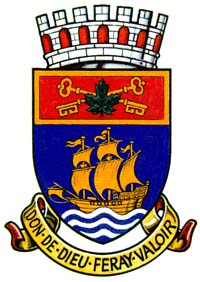

 he colors used in the coat of arms of Québec City possess a heraldic
significance: gold symbolizes strength, faith, justice, wealth, constancy and
splendor; silver: humility, purity, charity, truth and victory; azur:
sovereignty, majesty, serenity, good reputation, knowledge, clarity
and loyalty; gules: love, pain, grandeur, courage, generosity,
bravery and intrepidity; and green: hope, revival, abundance,
beauty, freedom and cheerfulness.
he colors used in the coat of arms of Québec City possess a heraldic
significance: gold symbolizes strength, faith, justice, wealth, constancy and
splendor; silver: humility, purity, charity, truth and victory; azur:
sovereignty, majesty, serenity, good reputation, knowledge, clarity
and loyalty; gules: love, pain, grandeur, courage, generosity,
bravery and intrepidity; and green: hope, revival, abundance,
beauty, freedom and cheerfulness.
 he ship represents the period when Québec was founded, in 1608, by
Samuel de Champlain, who came from Honfleur. It also represents
the maritime vocation of Québec with its important seaport. The
full sails symbolize the strength and courage of the population.
Each of the two keys has its own significance: the key on the right
symbolizes Québec as the capital of New-France, of Canada, at
the beginning of the English regime, and of Lower-Canada; the key on
the left represents the Capital of the province of Québec since
the Confederation. Together they symbolize the political and
municipal history of the City of Québec.
he ship represents the period when Québec was founded, in 1608, by
Samuel de Champlain, who came from Honfleur. It also represents
the maritime vocation of Québec with its important seaport. The
full sails symbolize the strength and courage of the population.
Each of the two keys has its own significance: the key on the right
symbolizes Québec as the capital of New-France, of Canada, at
the beginning of the English regime, and of Lower-Canada; the key on
the left represents the Capital of the province of Québec since
the Confederation. Together they symbolize the political and
municipal history of the City of Québec.
 he maple leaf symbolizes the canadian personality of the City of
Québec and represents all ethnic elements of its population, along
with the patriotic and civic spirit of its citizens. The
crown, on top of the escutcheon, reminds us that Québec is a fortified
city and that its founder, Champlain, also came from a fortified
town, Brouage en Saintonge.
he maple leaf symbolizes the canadian personality of the City of
Québec and represents all ethnic elements of its population, along
with the patriotic and civic spirit of its citizens. The
crown, on top of the escutcheon, reminds us that Québec is a fortified
city and that its founder, Champlain, also came from a fortified
town, Brouage en Saintonge.
 ast, the expression "Don de Dieu feray valoir" (which might be loosely translated as
"Gift of God shall make prosper") is a testimony of christian faith
symbolizing spiritual, moral and social virtues of the active
and courageous population of Québec, and embodies the ideal of
the city, drawn from the source of its foundation.
ast, the expression "Don de Dieu feray valoir" (which might be loosely translated as
"Gift of God shall make prosper") is a testimony of christian faith
symbolizing spiritual, moral and social virtues of the active
and courageous population of Québec, and embodies the ideal of
the city, drawn from the source of its foundation.